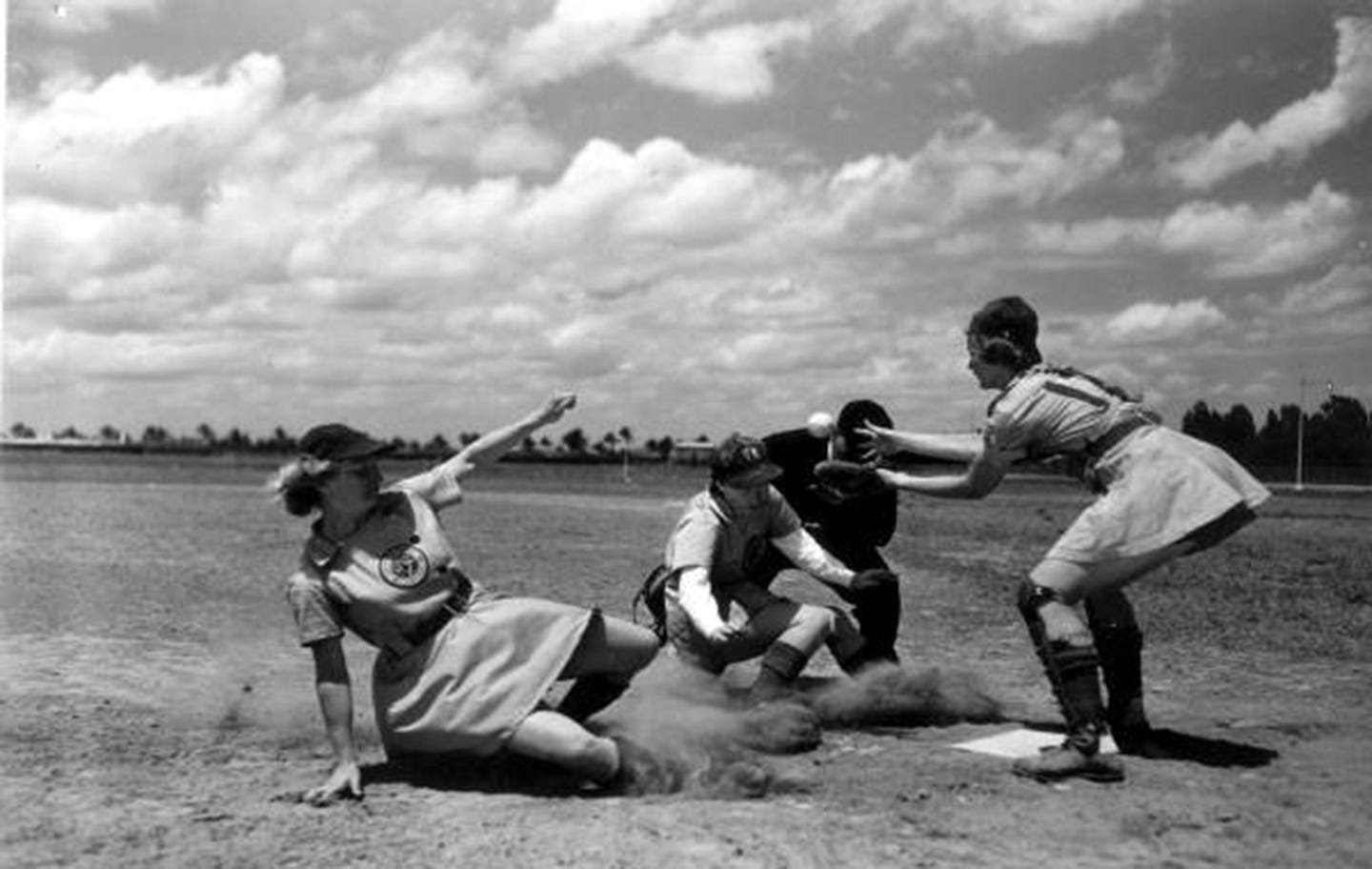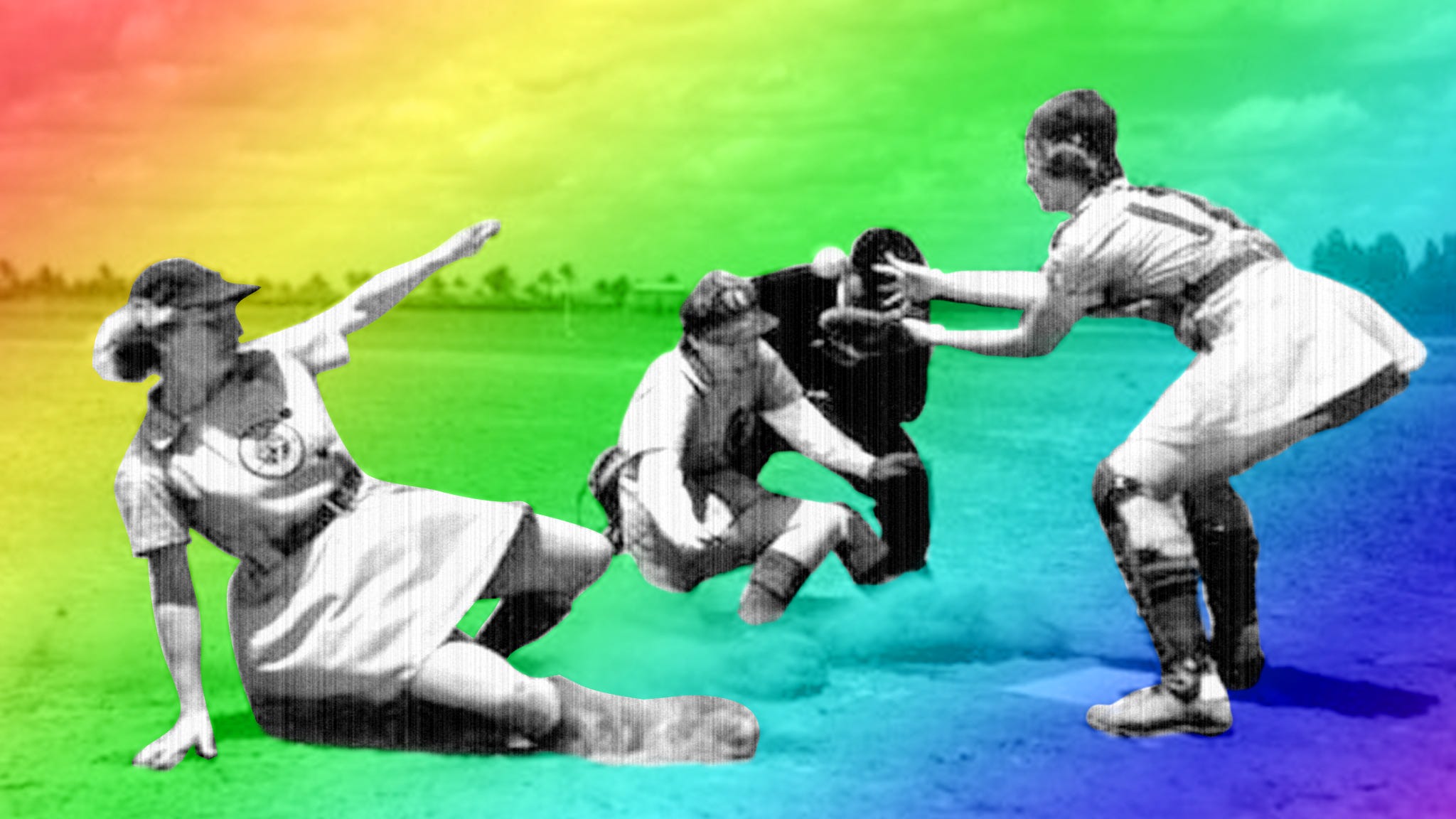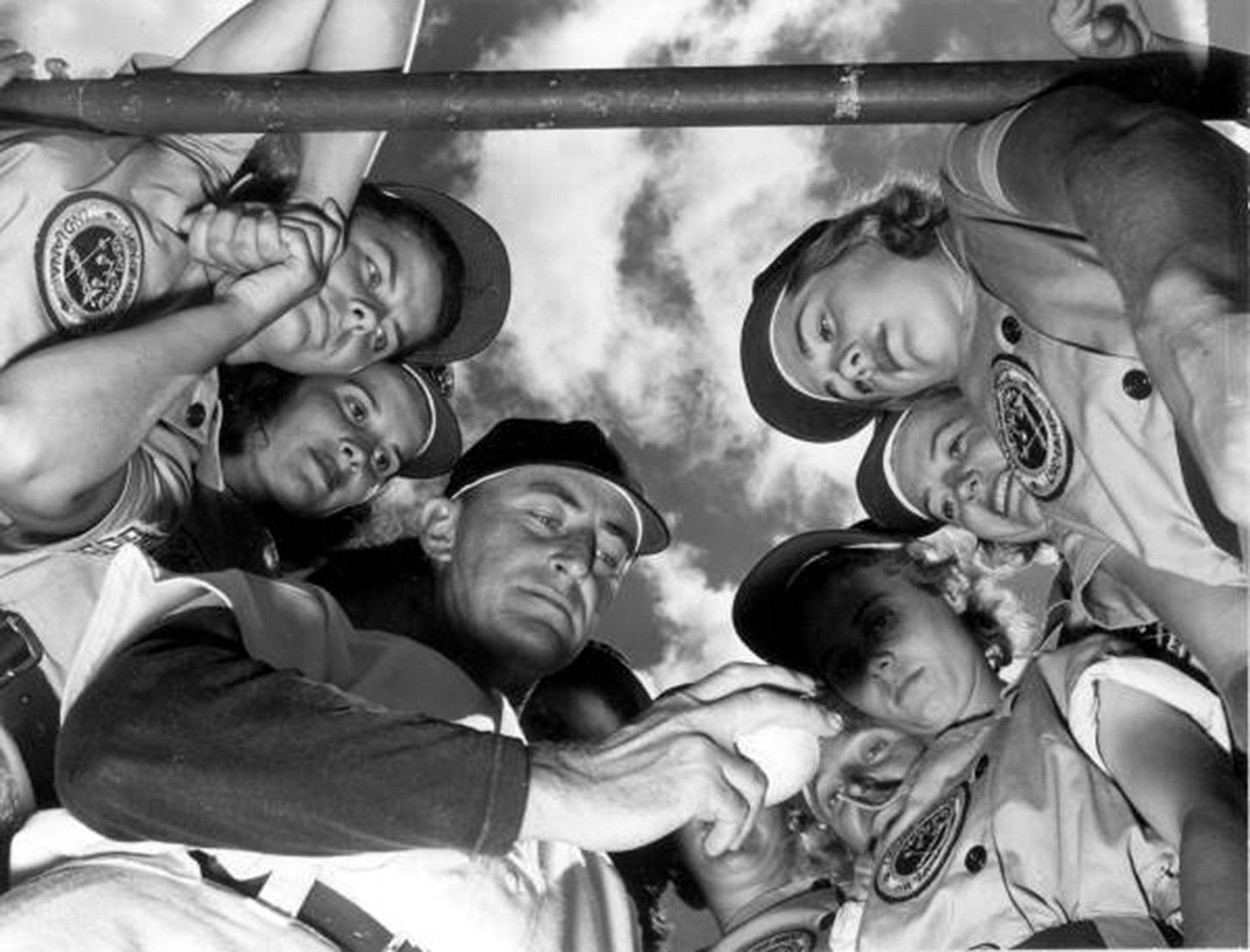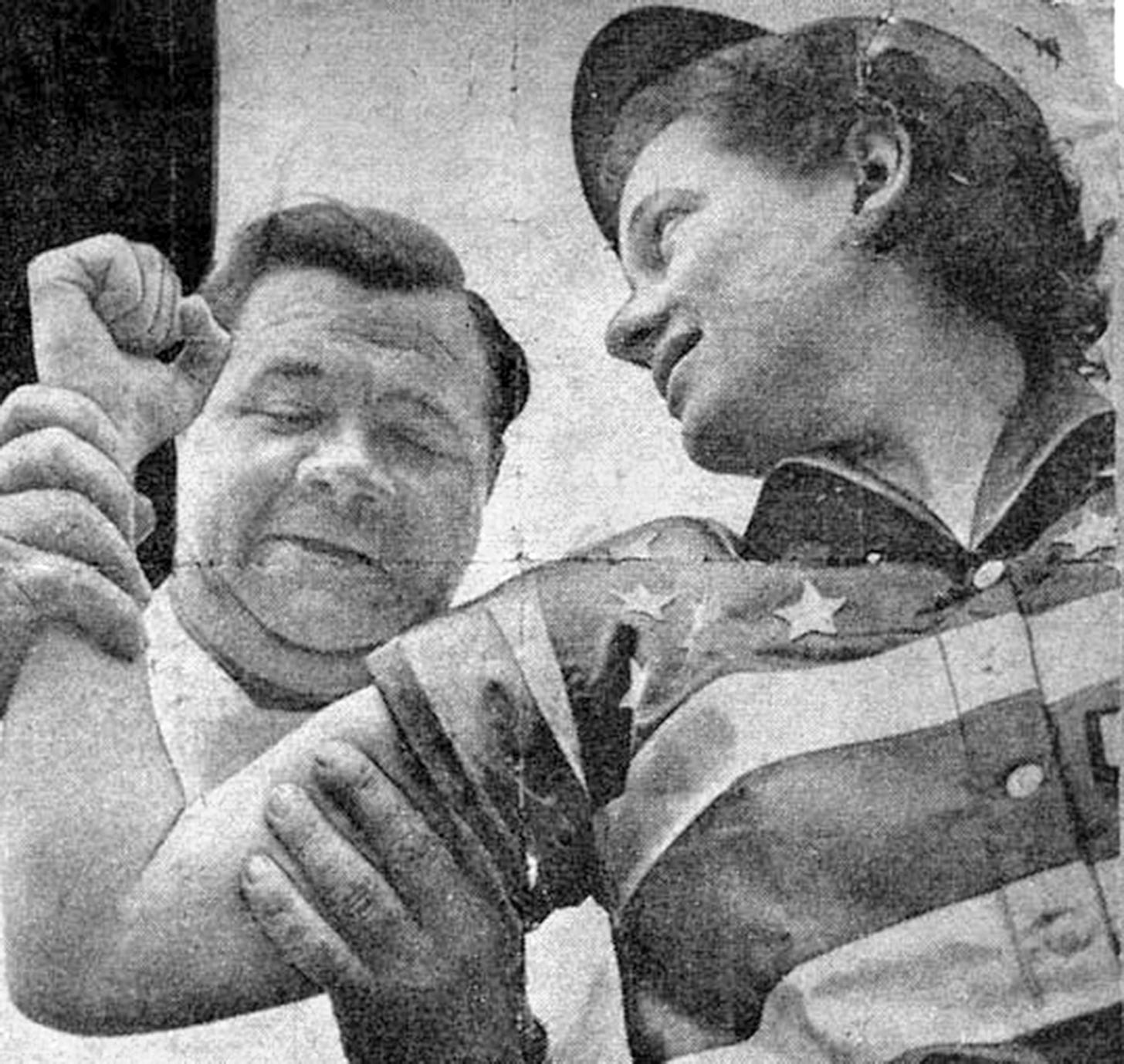The Hidden Queer History Behind "A League of Their Own"
The All-American Girls Professional Baseball League did everything it could to keep lesbians off the diamond. Seventy-five years later, its gay stars are finally opening up.
Josephine “JoJo” D’Angelo was in a hotel lobby in 1944. An outfielder for the South Bend Blue Sox — a team in the All-American Girls Professional Baseball League (A.A.G.P.B.L.), founded the year prior — she had dark, curly hair. Even if you didn’t know her last name, her looks hinted at her Italian heritage.
The hotel was likely decorated with muted colors in the modernist style of the previous decade. Thanks to World War II, there were supply shortages and rations, which put a hold on new design in the early ’40s. All available supplies needed to go toward the war effort.
The story was similar in baseball. With most of the Major League Baseball players deployed, executives decided to fill the gap with female players, paving the way for the A.A.G.P.B.L.
But in the hotel that day, D’Angelo was approached by one league executive and told that she was being released from her contract. This was devastating for the right-hander who’d batted .200 in her two seasons with the Blue Sox. She’d been playing since she was a little girl, and had spent her days working in a steel mill in her hometown of Chicago while devoting evenings to playing ball, before attending a tryout for the league at Wrigley Field. That scene was made famous by the film “A League of Their Own,” with hundreds of women traveling from around the country to the brick ballpark with the ivy-covered outfield wall.
Why was D’Angelo being cut from the thing she loved most in the world? When she told the story later in her life, she gave the reason: “a butchy haircut.” It was a haircut she says she never even wanted, one she was pressured into getting by the hairstylist who assured her she would look lovely with her dark curls trimmed into a bob.
D’Angelo had broken one of the cardinal rules of the A.A.G.P.B.L.: “Play like a man, look like a lady.” But she wasn’t the only one. Connie Wisniewski was told she’d be kicked off her team if she chose to get a close-trimmed cut. Multiple recruits were immediately handed tickets home after they showed up to spring training with bobs, and “Dottie Ferguson was warned by her chaperon against wearing girls’ Oxford shoes, because they were excessively masculine-looking,” writes Lois Browne in her book Girls of Summer: In Their Own League.
Players had to attend charm school and wear lipstick on the field. Their uniforms had skirts instead of pants — not great for sliding, but deemed appropriately feminine by league owner Philip K. Wrigley. All of this was chronicled in “A League of Their Own.” But there was one thing the movie left out: the reason for these requirements.
Though it was never explicitly stated, historians and players alike say the rules were in place, in part, to prevent the women from being perceived as lesbians. Many of the women actually were gay, including D’Angelo, which is another part of the story the movie didn’t tell. By not including a gay character’s story in “A League of Their Own,” the film does to the history of the league what the owners tried to do its existence — erase lesbians from the narrative.
When Terry Donahue met Pat Henschel in 1947, Donahue was a 22-year-old catcher and utility infielder in the All-American Girls Professional Baseball League. She grew up playing ball with her younger brother, Tom, on their family’s farm in Saskatchewan, Canada. “She claimed that she was five-foot-two. She was about five-foot,” Henschel tells me over the phone from the home she shares with Donahue. “She had dark hair, blue eyes, and was very attractive, and she was wonderfully liked.”
Donahue was in Nova Scotia for the winter when she met Henschel, who was 19 at the time. The two women hit it off, keeping in touch when Donahue moved back to the U.S. to play for the Peoria Red Wings. “She was a utility player, and the catcher on her team broke her thumb or her finger,” Henschel says. “The manager came up to her and said, ‘Have you ever caught?’ And Terry said, ‘no.’ He said, ‘Well, you’re going in tonight.’” The first game Donahue ever caught ended up being a 19-inning game. The next day was her birthday.
“The only things [women] can’t do, we can’t hit as far and we can’t throw as hard, but we certainly can make all the plays that you see in the Cubs’ ballpark. Or the Sox,” Donahue told the Kane County Chronicle in 2010, referring to the Cubs and White Sox, Chicago’s two major-league squads.

Today, Donahue, who has Parkinson’s disease, is 92. Henschel is 89. For seven decades the two told almost everyone, aside from their inner circle, that they were best friends. The Chronicle story calls Henschel Donahue’s “cousin and roommate.” But the truth was much more than that. For 70 years theirs has been a love story, originating in a time when the only love stories we were allowed to tell were those between a man and a woman. Try to ask most former players about the issue and they clam up. “I don’t think it was really even talked about, frankly,” Henschel says.
In the ’40s and ’50s, homosexuality was not discussed much; it wasn’t until 1973 that the American Psychiatric Association removed it from the list of mental illnesses. The players could have lost more than just their baseball careers if they had been open about their queerness. They could have lost their families, occupations, and reputations, too. In those days, “you had to be very discreet, and we were,” says Henschel. “No one was even aware of it because we got so careful and no one would have even imagined anything at all.”
That stigma has carried on for decades. As Ila Borders, the first woman to play for a men’s professional baseball team since the Negro Leagues, wrote in her memoir, Making My Pitch, “I remain certain that my professional career would not have been possible had I come out.” In 1994, Borders, a left-handed pitcher, became the first woman to receive a college baseball scholarship. She was the first to start an N.C.A.A. baseball game and the first woman to get a win in collegiate baseball. She then played for the independent, otherwise all-male St. Paul Saints and Duluth-Superior Dukes.
“In 1994 few in baseball — or in the country — were ready to accept a gay player, male or female,” writes Borders. Indeed, that same year, the book SportsDykes: Stories From On and Off the Field was also published. In her essay, “The Lesbian Label Haunts Women Athletes,” Lynn Rosellini writes, “To most lesbian athletes … coming out is not yet worth it.”
“If a woman plays hardball, people figure she’s likely gay,” writes Borders. It’s why, during her baseball career, she constantly had to answer questions about whether she dated men, and had to reassure the public that, despite the fact that she played ball, she was not gay. She understands today that talking about being a gay athlete is a double-edged sword, in a way. There’s the stereotype that women athletes are all lesbians, which is both inaccurate and unfair. And yet, there’s also the truth that there are many athletes who are also lesbians.
“I was deeply ignorant of my small place in the history of women athletes and the whole gay rights movement,” Borders writes of her playing days as a closeted homosexual.
But this stereotype existed long before Borders was even born. Some A.A.G.P.B.L. players cited masculine clothing or appearances as tipping them off about a woman’s sexual orientation, a stereotype that still exists today and may or may not be accurate. “The lesbians, they dressed like men with those big pants and big shoes, most of them. … [T]hey had boyish bobs,” Dottie Green, a former A.A.G.P.B.L. player and chaperone told Susan K. Cahn in her book Coming on Strong: Gender and Sexuality in Twentieth Century Sports. Or, as Dottie Ferguson Key put it, “tomboyish girls” who “wanted to go with other girls” signaled it with their “mannish” shoes and clothing.

It was this perception of female athletes as unfeminine and unfeminine women as lesbians that led Wrigley, a chewing gum manufacturer and president of the Chicago Cubs, to insist that his players be appropriately feminine in appearance.
But the A.A.G.P.B.L. went even further than that, instituting a policy against fraternizing with other teams. The given reason was “to sustain the complete spirit of rivalry between clubs,” but Browne writes that the real reason that teams imposed stiff fines on players who violated this rule was the fear of lesbianism. When the affair was between teammates, chaperones would refuse to let the suspected couple room together and gauge the reaction of the players to confirm their hunch. In one case, the suspected lovers were so angry about being barred from becoming roommates that team manager Johnny Gottselig considered it proof of the affair. One manager released two of his players because he thought they were gay and was worried they would “contaminate” the rest of the team.
In another case, a married player was rumored to have fallen for one of her teammates. “That player converted this young married woman in just two weeks,” said Fred Leo, who was the League’s publicity director and, later, its president. Another time, Leo said that a married player was discovered to be in a relationship with a woman who was unassociated with the league. Leo claimed he notified her husband, who came and took her home.
“Knowledge of gay women in sport ranged from a hazy, unarticulated awareness to an informed familiarity or personal involvement,” writes Cahn. “Often an athlete’s initial awareness of lesbianism developed from seeing women ‘pairing off’ or getting ‘very clannish’ with each other.”
However, many of the players came to the league quite sheltered. They often arrived from small towns or rural areas and were quite young when they left home. As a result, it was not uncommon for new or younger players to be completely blindsided by the relationships between their teammates. Dorothy Hunter entered the League in 1943, when she was 27. Hunter, who was from Winnipeg, Canada, said she had “never heard of lesbianism,” so her teammates regaled her with tales of lesbian love affairs. “They told me they had wedding ceremonies. Well, I just thought they were giving me the gears because I was a green Canadian.”
But many of the players were unattached. If straight players were married, many of their husbands were off at war or were left back at home on farms or in factories. The players’ grueling schedule and constant travel made dating difficult. It was in many ways the perfect environment for gay women to become involved with each other. But in some cases, the near-inability to date was a welcome reality. It made staying in the closet easier, because there was no time for dating and so there was no need to make excuses. This was something that Borders discovered, too, when she was playing ball in the 1990s.
“Playing baseball allowed little time for dating,” she writes. “When people tried to set me up, it was easy to say, ‘No thanks, too busy.’”
These restrictions kept some women out of the league altogether. One of those women was Dot Wilkinson, often regarded as the greatest softball player of her time — and perhaps all time. Wilkinson was a hard-playing catcher for the Phoenix Ramblers. She joined the American Softball Association (A.S.A.) team in 1933, when she was just 11 years old.
“Softball has meant more to me than I can ever tell anybody,” Wilkinson says in the documentary film “Extra Innings.” “I love that game. I never thought about anything else.”
Wilkinson was recruited to play in the A.A.G.P.B.L. “They came to Arizona to offer us some contracts,” Wilkinson said. “They wanted to give me $85 a week [equivalent to $1,240 today] to catch. I didn’t want to leave the Ramblers and I don’t like being away from home so I didn’t go.”
But it was more than that. Wilkinson didn’t want any part of the curfews, the charm school, the chaperones, or the mandatory dresses. She played in Levi’s or her shiny satin uniform shorts, and she liked it that way. She also knew that the league was actively discouraging players from being perceived as exactly what Wilkinson was — gay.
“Softball was my first love and it still is,” said Wilkinson. But she had another love, too. In 1963, Estelle “Ricki” Caito, a star second baseman, joined the Ramblers. Wilkinson and Caito played together for two seasons, until the A.S.A. disbanded. But they also began a relationship that would last 48 years, until Caito’s death in 2011.
“We were born at a time when we were all in the closet and that was just the name of the game,” Wilkinson said. “And you had to live with it and that’s what we did.”
It is the obituaries that offer the most publicly available clues to some of the players who spent their lives with other women. The most telling evidence is often in veiled language or titles that are open to interpretation. In at least one case, a player had a “special friend.” In others, their relationships are more explicitly acknowledged.
Mabel Holle played third base for the South Bend Blue Sox, and like teammate JoJo D’Angelo hailed from Illinois. Holle’s father was a semi-professional pitcher and she grew up playing ball with her siblings. She attended the mass tryout at Wrigley Field, becoming one of the original members of the league in 1943. During the season, she was traded to the Kenosha Comets. Her contract was not renewed in 1944, forcing her to try out again. This time, she didn’t make the cut. After leaving the league, she became a physical education teacher. In Holle’s 2011 obituary, written after she died at 91, there’s this: “Holle is survived by her longtime partner, Linda Hoffman.”
Mildred “Millie” Deegan played 10 seasons with the A.A.G.P.B.L., from 1943-1952. She is rumored to have impressed Babe Ruth with how far she could hit a softball, and it is said he squeezed the biceps on her arm when he posed with her for a photo. In 1944 the Brooklyn Dodgers invited Deegan and two other women to their spring training camp. Leo Durocher, the Dodgers manager, told the Daily Oklahoma in 1946, “Deegan spent a whole week training with the Brooklyn Dodgers at their Bear Mountain, NY camp. If she were a man, she no doubt would have been a Dodger.”
Deegan died of breast cancer in 2002 at the age of 82. Her obituary in the New York Times mentions Margaret Nusse, “Ms. Deegan’s companion and her only survivor.” Nusse, known as “Toots,” was a softball legend herself. According to the now-defunct NJ Divas Fastpitch site, Deegan and Nusse were partners for almost 50 years. The two shared their passion for softball: Deegan was the coach for the Linden, New Jersey, Arians and Nusse was the manager. Nusse passed away just six months after Deegan died, at age 85.
June Peppas was a pitcher and first baseman from Fort Wayne, Indiana, who played in the A.A.G.P.B.L. from 1948-1954. The player known as “Lefty” had spunk. Fort Wayne Daisies manager Harold Greiner relates a story in Browne’s book Girls of Summer: “Once there were some men out in the street, and some smart aleck said something. I didn’t hear what it was, they’d watched till I wasn’t nearby. Anyway, all of a sudden I hear ‘Wow!’ I turned around and saw that June Peppas had decked the guy — and I mean she really decked him. He crawled away.”
The A.A.G.P.B.L. meant a lot to Peppas. She was the first chairperson of the Players Association Board and two-time A.A.G.P.B.L. All-Star. Polly Huitt was Peppas’s partner for 46 years before she passed in 2007, nine years before Peppas died at the age of 86. The two operated a printing business in Allegan, Michigan, called PJ’s Printing, from 1975-1988. They sold the business and retired to Florida where, according to Peppas’s obituary, they enjoyed “golf and an active social life.”

One of the best pitchers to ever play in the A.A.G.P.B.L. was Jean Cione. The girl from Rockford, Illinois, played 10 seasons in the league. In that time she threw three no hitters, had three 20-win seasons, and had an unassisted triple play — something that has only happened 15 times in Major League Baseball since 1909. Cione spent her rookie year in 1947 with the Rockford Peaches and finished with an astonishing 1.30 ERA. “She was a lot fun to be with,” Cione’s partner Ginny Hunt told the Bozeman Daily Chronicle after her death in 2010. “If you didn’t ever experience watching a baseball game with her, you really missed something. It was a treat to watch a game with her. She analyzed every play.”
Catcher Eunice Taylor and her partner of 45 years, Diana Walega, owned and operated a pet supply store for 40 years. Outfielder Barbara Sowers was with her “loving companion” Shirley Ann Weaver for 45 years. And there are many more, players with “longtime,” “beloved companions,” whose names I have chosen not to include here out of respect for the fact that they were likely still closeted during their lives. Their obituaries, which are historical documents, offer us glimpses into their lives and are open for us to interpret.
“Our relationship is one of the best,” Pat Henschel says of her partnership with Terry Donahue. “We’re very lucky and we know it.”
Photos of the women throughout the years give a glimpse of the life they’ve had together. In their younger days, they look like they could be sisters as they pose in front of a Christmas tree in a picture that might have been taken in the 1960s. They each sport short, dark hairstyles and wear sleeveless turtleneck shirts. In another, they are perhaps in their 60s and they dance together in front of a fireplace. They are both laughing. Their hairstyles have not changed in the decades between the two photos except to turn from brown to gray.

They are ready to tell the world the truth about their relationship. Donahue’s great nephew, Christopher Bolan, is working on a documentary about their life together. Another photo shows the two of them doing what they had only ever done behind closed doors: they hold hands, weathered and wrinkled by the years they’ve spent together, and they kiss each other on the lips. Their eyes are closed. It is sweet. It is intimate. But they hid this truth for as long as they did because, for most of their lives, they had too much to lose by coming out.
But today, Henschel says, “They either accept it or they don’t.”
Fifty years after the All-American Girls Professional Baseball League ended, Ila Borders was making history. She had ascended to a level that no woman ever had before. She was playing — and succeeding — in men’s professional baseball. And then, she quit.
We are sitting together in the stands at JetBlue Park, the Red Sox’s spring training facility in Fort Myers, Florida. We’re watching a group of women play the championship game at the team’s Women’s Fantasy Camp, where Borders is coaching. “It got to me,” Borders says about being in the closet. “It’s why I quit. It’s the worst thing on Earth to hide who you are.”
That, Borders says, is why she ultimately came out — for the next generation of girls who want to play ball, so they can be themselves, no matter who they are, and so history doesn’t have to repeat itself.
Borders looks out onto the field of women whose uniforms are streaked with dirt. “If you are a ballplayer, it’s O.K. to play hard and just be yourself,” she says. And she’s finally at a place in her life where she truly believes it.
Frankie de la Cretaz is a freelance writer whose work has been featured in the New York Times, Rolling Stone, Bleacher Report, espnW, Vogue and more. In 2017, they won the Nellie Bly Award for Investigative Journalism from the Transformative Culture Project for their work on racism in the Boston sports media landscape.








